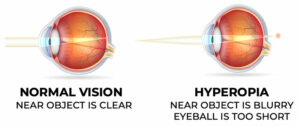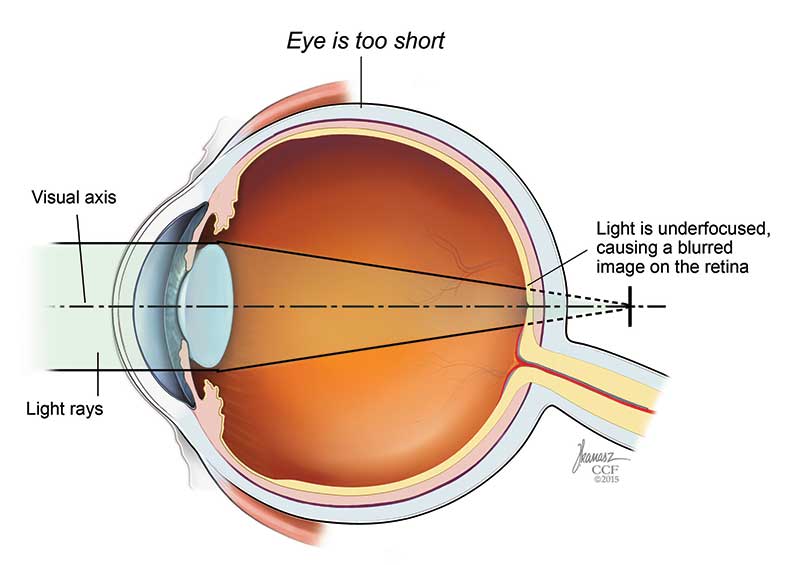Farsightedness, also called hyperopia, is a common type of refractive error where light focuses behind the retina instead of on it. This causes distant objects to appear blurry while close objects may appear clear. Farsightedness can occur in people of all ages, but it’s more common in children than adults. Most people with mild farsightedness don’t experience any symptoms. But if your farsightedness is severe, you may have trouble seeing objects at all distances, including up close. In this blog, we’ll discuss the causes, symptoms, and treatments for farsightedness and how to prevent it from worsening. We’ll also discuss ways to improve your vision if you already have this eye problem.
Contents
What is Farsightedness?

Farsightedness, also called hyperopia, is a refractive error of the eye where distant objects are seen more clearly than close ones. This happens when the eyeball is too short or the cornea (the clear front surface of the eye) has too little curvature. As a result, light rays entering the eye are not focused correctly on the retina (the back of the eye), causing distant objects to appear blurry.
Farsightedness is a common condition that affects people of all ages. It usually isn’t serious, but can be uncomfortable if not corrected. People with farsightedness may have difficulty reading up close and may experience headaches or eye strain.
There are two main types of farsightedness: simple and accommodative. Simple farsightedness occurs when the eyeball is too short or the cornea has too little curvature. This type of eye problem cannot be corrected with eyeglasses or contact lenses. Accommodative farsightedness occurs when the eye muscles are unable to focus light properly on the retina. This type of eye problem can be corrected with eyeglasses or contact lenses.
Farsightedness can be treated with eyeglasses, contact lenses, or refractive surgery. The best treatment for you will depend on your age, health, and lifestyle.
Causes of Farsightedness
The reasons for farsightedness (hyperopia) are varied and include:
Genetics
One of the most common reasons for farsightedness is genetics. If one or both of your parents are farsighted, you will likely be as well.
Eye shape
In some cases, farsightedness can be caused by an eye that is shaped more oblong than normal. This shape prevents light from focusing properly on the retina and causes distant objects to appear blurred.
Presbyopia
This condition occurs naturally with age and is caused by a decrease in the elasticity of the lenses in the eyes. This can lead to difficulty focusing on close objects but often leads to improved vision at a distance.
Aging of the eyes
As we get older, our eyes do too, causing them to lose some of their ability to focus clearly on close objects. This age-related condition usually becomes worse with time and may eventually require corrective lenses or surgery to improve vision.
Nearsightedness
Some people who are nearsighted (myopic) may also develop farsightedness. This happens when the eye becomes so elongated that it causes light to focus behind the retina instead of directly on it.
Symptoms

Farsightedness, or hyperopia, is a common vision condition that affects millions of people worldwide. If you have farsightedness, your eyes may not be able to focus on close objects as well as distant ones. This can make reading and other close-up work difficult.
Symptoms of this eye issue can include:
Trouble seeing objects that are up close
One of the most common signs of farsightedness is difficulty focusing on objects that are close up, such as books or a computer screen. This also makes it a challenge to read for long periods.
Eyestrain and headaches
Straining your eyes to see close objects can lead to eyestrain and headaches. This is because the effort involved in focusing on nearby objects causes extra strain on the eyes.
Blurry vision
Farsightedness can also cause your vision to become blurry, both near and far. This can make activities like driving difficult, as you may not be able to see clearly either far away or close up.
Difficulty reading small print or seeing fine details
This is another common symptom of farsightedness. You may find it difficult to read small print or see the fine details in objects.
Squinting
Another sign of farsightedness is squinting, which is an effort to focus on close objects. Squinting can lead to headaches and eyestrain and should be avoided as much as possible. A visit to an optometrist or ophthalmologist is recommended if you experience frequent squinting. We provide effective Squint Surgery.
Diagnosis of Farsightedness
The most common way to diagnose eye problems is through a vision screening or a comprehensive eye exam. During a vision screening, an eye chart is used to measure how well you see at different distances. If you have farsightedness, you may be able to see far-away objects more clearly than those up close. A comprehensive eye exam will also test your ability to see at different distances and can help determine the cause of your eye problem.
The other diagnosis method of farsightedness is called refraction. During this procedure, the doctor will use a machine to measure how well your eyes focus on various objects at different distances. If you have farsightedness, the machine will detect that your eyes don’t focus as quickly or clearly on near objects as they do on far objects.
The doctor may also use a retinoscopy to diagnose farsightedness. During this procedure, the doctor will shine a light into your eye while moving different lenses in front of it. If you have farsightedness, the doctor will be able to detect an increase in refractive power when the lens is moved away from your eye. Retinoscopy is the least used method to diagnose farsightedness.
Treatment of Farsightedness

There are two primary treatments for farsightedness: glasses or contact lenses. Each has its own set of pros and cons that you should discuss with your doctor.
Contact Lenses
One of the most common treatments for this eye problem is contact lenses. Contact lenses effectively correct refractive errors by changing the way light enters the eye and focusing it onto the retina. They come in both soft and rigid forms, with soft contact lenses being the most popular choice. Soft lenses provide a level of comfort that rigid lenses cannot match and can be worn for extended periods without risk of damage to the eye or discomfort.
Glasses
Prescription glasses are another common treatment for this. Just like contact lenses, glasses work by changing the way light enters the eye to better focus on the retina. Glasses require less maintenance than contacts as they do not need to be cleaned or replaced as often. However, they are not as comfortable as contacts and can be prone to slipping off when engaging in physical activities such as sports.
Prevention of Farsightedness
There are a few things that can be done to prevent farsightedness, or hyperopia, from occurring. Some of these are:
1. Wearing glasses or contact lenses: If you already have them, wearing corrective lenses can help reduce their effects.
2. Eating a healthy diet: Eating a nutritious diet with plenty of fruits and vegetables can help keep your eyes healthy and reduce the risk of farsightedness.
3. Getting regular eye exams: Regular eye exams allow doctors to detect any vision problems early so they can be treated quickly.
4. Doing eye exercises: Doing eye exercises such as focusing on distant objects or rotating the eyes in circles can help strengthen the muscles in the eyes, which may help reduce the risk of developing farsightedness.
5. Avoiding excessive strain on the eyes: Prolonged exposure to screens and reading in dim light can cause eye strain, which may contribute to farsightedness. Taking regular breaks from screens and using proper lighting when reading can help reduce this risk.
6. Wearing sunglasses when outdoors: Wearing sunglasses can help protect your eyes from UV rays, which can damage the eyes and increase the risk of developing farsightedness.
Conclusion
Farsightedness is a common eye condition that can be easily corrected. You can restore clear vision to its maximum potential with the right diagnosis and treatment plan. Ophthalmologists typically use glasses or contacts to correct farsightedness, but there are also surgical options available if necessary. We hope this article has provided you with a clearer understanding of hyperopia and given you the information needed to make sure your eyes stay in top shape.
Lasik surgery is a safe 10-minute procedure to help you get rid of glasses. MantraCare offers the most advanced LASIK options. If you have any questions on LASIK surgery feel free to reach out to us at +91-9711116605.
